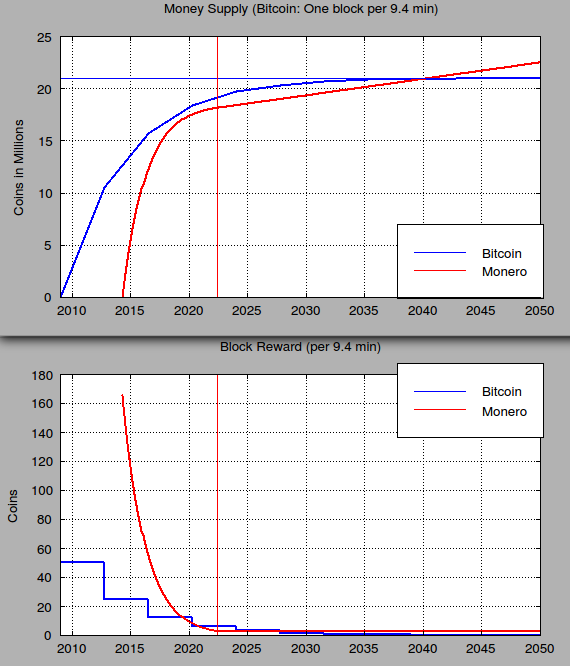Key highlights:
- Different cryptocurrencies have different approaches to managing the creation of new coins
- Monero developers have chosen a more gradual approach compared to Bitcoin's halving.
- In May 2022, Monero will enter the tail release phase.
The cryptocurrency world is incredibly diverse, and cryptocurrency projects take different approaches when deciding how to create new coins. For example, Bitcoin has a maximum supply of 21 million coins, and the rate at which new BTC is put into circulation is halved during the Bitcoin halving, which occurs every four years. So, while over 18 million BTC have been mined in just over a decade, the 21 millionth Bitcoin will not be mined until around 2140.
Bitcoin's approach is not the only viable option: in Dash, for example, the block reward decreases by about 7% every 383 days.
In this article, we will focus on Monero, the most popular privacy coin on the market today. Monero also has a mechanism to reduce the issuance of new XMR over time, but it takes a relatively unique approach. While there is no Monero halving, the Monero protocol still has a mechanism in place that gradually reduces the amount of XMR coins issued over time.
What is Monero?
Before we take a closer look at Monero’s supply trends, let’s learn a bit more about this fascinating cryptocurrency project.
Basic information about Monero:
- Launched in 2014
- Proof of Work Cryptocurrency
- The most popular privacy coin on the market
- ASIC Resistance
Monero is a privacy-focused cryptocurrency that hit the market in 2014. Its consensus mechanism is conceptually similar to Bitcoin's, as Monero also uses Proof-of-Work to achieve consensus, however, Monero implements measures to prevent mining using specialized ASIC chips (ASIC stands for Application Specific Integrated Circuit).
Unlike Bitcoin, Monero can be profitably mined on consumer computer hardware: Ethereum's RandomX PoW algorithm is designed to be particularly efficient when mined with a CPU (Central Processing Unit), meaning that anyone with a reasonably powerful computer can mine Monero.
Those with access to more powerful CPUs still have an advantage, but mining Monero is much easier than mining non-ASIC-resistant cryptocurrencies. ASIC mining rigs cost thousands of dollars each and are unable to perform any useful work other than mining cryptocurrencies.
The Monero project places a strong emphasis on privacy, and all transactions made with XMR are completely private. External observers cannot see the addresses or amounts involved in Monero transactions. The Monero cryptocurrency achieves this high degree of privacy through a variety of technologies, including stealth addresses, ring signatures, and RingCT. Another benefit of Monero being private is that XMR coins are completely fungible.
Buy/Sell Monero (XMR)
Monero's “Halving” Explained
Like Bitcoin, Monero is a proof-of-work cryptocurrency, which means that Monero miners must deploy computer hardware to solve resource-intensive mathematical problems in order to have a chance of adding the next block to the Monero blockchain and earning the associated block reward. Monero is designed so that a new block is added to the Monero blockchain approximately every two minutes.
Monero Mining
Monero is a proof-of-work coin, but it has a number of unique aspects. First, Monero is a bit different from most other proof-of-work coins because it has no cap on its maximum supply. While Monero's maximum supply is technically infinite, this doesn't have a huge impact from a practical standpoint. You'll see why in a moment.
Additionally, Monero's RandomX Proof-of-Work algorithm is specifically designed to thwart ASIC miners, allowing Monero to be effectively mined with consumer computer hardware. The algorithm is designed to be particularly efficient for users who mine using their computer's CPU (Central Processing Unit).
So, is there such thing as a Monero halving?
The short answer is no, but as mentioned above, Monero has a mechanism to gradually slow down the rate at which XMR coins are created. As of May 2022, Monero has entered a state of “tail emission”, meaning that the block reward will be permanently pegged at 0.6 XMR. Assuming a block time of 2 minutes, from that point on, approximately 432 XMR will be created every day, unless the Monero protocol changes. As of this writing, there are 18.14 million XMR coins in circulation.
Monero will always have inflation (although the inflation rate will decrease over time), but continuing to provide incentives to miners beyond transaction fees makes the Monero network more secure. Cryptocurrencies with limited supply, such as Bitcoin, may face problems in the future where miners must rely primarily on transaction fees to fund their operations.
Monero Tail Release vs Bitcoin Halving
Unlike Monero, some cryptocurrencies, such as Bitcoin, eventually become deflationary as their effective supply decreases over time as new coins are not created and users lose access to them.
While this scenario may seem attractive to price speculators at first glance, there is a risk that transaction fees alone will not be enough to incentivize miners to provide sufficient hashrate. Such a scenario could also undermine the security of the Bitcoin network and lead to a decline in the value of BTC.
Every time Bitcoin halving occurs, miners must rely on an increase in the price of Bitcoin or an increase in transaction demand on the Bitcoin network to continue making mining profitable. Otherwise, some miners will be forced to stop mining, which will result in a decrease in the overall hashrate and weaken the security of the Bitcoin network.
This handy chart, provided by Reddit user u/Amichateur, comparing Monero and Bitcoin supply trends, can be used to better visualize Monero's time release.


